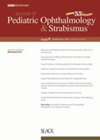
Journal Reviews
Does delayed strabismus surgery have an association with psychiatric diagnoses in children?
The authors present a retrospective cohort study with the aim of assessing the association between strabismus surgery in early childhood and psychiatric diagnosis incidence. An international healthcare records platform was utilised to access electronic medical records from 92 healthcare organisation....
High prevalence of strabismus and variable surgical success in children with developmental delay
On the basis of lack of consensus for the treatment of strabismus in children with developmental delay, the authors reviewed the literature to provide information on the topic and present results from their clinical experience. From the review, they include...
RCT of surgery to correct asymmetrical DVD
This study compared the efficacy of two procedures: (1) bilateral symmetrical anteriorisation of the inferior oblique (AIO) and (2) combined resection and AIO, in cases of asymmetrical dissociated vertical deviation (DVD). This was a prospective randomised controlled trial including 54...
Treatment of anisometropia and strabismus amblyopia with syntonic phototherapy
Syntonic phototherapy is a non-invasive light therapy treatment using specific light colours, frequency and wavelength to improve body regulatory centres in the brain. It is proposed that red light increases cell membrane capacitance buildup of electrical charge before discharge that...
Short-term instability of surgical correction of IXT
In this retrospective observation study from southern India, the authors aimed to evaluate the progression of intermittent exotropia (IXT) following surgical correction and its contributing factors in 50 patients. Mean age at surgery was 10 years (range 6–14), 26 were...
Comparison of two surgical procedure options for unilateral superior oblique palsy
This study compares two surgical options for management of unilateral superior oblique palsy with angles >20PD. Group 1 underwent one vertical muscle surgery – ipsilateral inferior oblique anterior transposition plus resection (IOATR). Group 2 underwent two vertical muscles surgery –...
Strabismus prevalence in a Pakistan population
The aim of this study was to compile the available literature reporting the prevalence of strabismus in Pakistan and calculate the pooled prevalence of strabismus in the Pakistan population. Meta analysis was conducted with 10 studies with a total of...
Suitability of online materials for strabismus
In this study, the authors aimed to evaluate and compare online materials about strabismus using expanded metrics including readability, complexity and suitability. They highlight areas of improvement for better counselling of patients on the internet. Ten top web pages were...
Clinician predictions and the perspectives of parents prior to strabismus surgery compared
The aim of this study was to assess the perspectives and concerns of parents in relation to exotropia surgery in comparison to how clinicians predicted parents would respond. Parents of children with intermittent exotropia who underwent surgery over a nine-month...
Augmented surgery with BTA for large angle strabismus correction
This retrospective study reports the results of botulinum toxin A (BTA) augmented bilateral recession or monocular recession / resection (RR) for patients with large angle strabismus. Twenty-four patients were recruited: 10 female, mean age 9.2 ±13.6 years, 20 esotropia and...
Changes in retinal and choroidal microcirculation after strabismus surgery
The aim was to evaluate retinal and choroidal microcirculation using optical coherence tomography angiography after strabismus surgery. This was a cross-sectional observation study of 44 eyes of 44 patients. Patients were split into three groups: (1) one-muscle horizontal surgery (n=9);...
Use of the Mendonca strabismus forceps in locating and measuring muscle insertions
The authors aimed to compare the reliability of the Mendonca strabismus forceps vs intraoperative calliper measurements for determining the distance from the limbus to the insertion of the extraocular muscles in patients undergoing strabismus surgery. This was a prospective observation...










